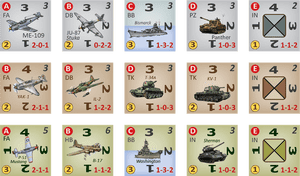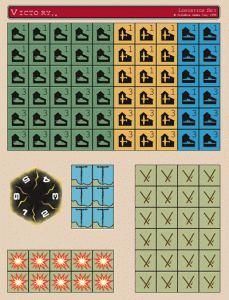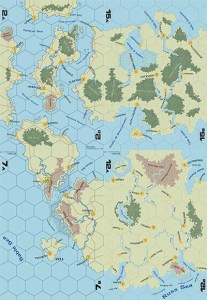THUNDER IN THE EAST
from
VICTORY POINT GAMES
When I reviewed Nemo's War, I didn't think that Victory Point Games could surpass the level of quality shown in that game. In some respects I was right. It's hard to imagine that the quality of artwork, the thickness of counters, the superb mounted game board and the glossy rule book could be improved on. BUT, Thunder in The East [TitE] has certainly moved the goalposts in other areas of VPG's output.
This may be no surprise, considering that the game's designer is the legendary Frank Chadwick co-founder of GDW [Games Designers Workshop] back in the 70s when my boardwargaming days began. Famed for an amazing diversity of games, perhaps two stand out: Traveller the iconic role-playing sci-fi and the Europa series covering WWII.
There can be no doubt that Thunder in The East is a proud descendant of that series. This first instalment in Frank Chadwick's intended magnum opus series titled European Theater of Operations [ETO] is massive, just as its designer's ambitious intentions are massive. There have been some quibbles on the various forums over whether it is a "monster" game or merely a "mini-monster" - let's just settle for it's BIG, BIG, BIG! To be precise 124 cm x 95cm or, as the back of the box surprisingly tells us in these metric days, 49 inches x 41 inches!
This superb map gives room to play out the whole of the WWII on the Russian Front from 1941-1944. So, perhaps by the standards of 1973 when it took two massive games [Drang Nach Osten and subsequently Unentschieden] made up of 9 maps in total to cover the same geographic area and timescale, TitE is a not as physically daunting, but it still means that my camera couldn't do full justice to the map!
Let me say that I love the assembled maps, for the manageable size [I haven't had to have my arms forcibly extended], clarity of detail, colour blends and perfect alignment. There has been, in my opinion, undue criticism of the fact that the smaller south eastern map's colour match is slightly lighter. I've found it neither any hindrance to play nor to the overall aesthetics of the game.
Unfortunately some copies have had misaligned counter printing which in our age of immediate reaction tends to produce intemperate online postings. A simple request to VPG is the solution, not an online outburst. From a range of companies over the years I've experienced everything from missing counters,maps and a rulebook as well as misaligned counters [in that last case, over 50% of the reverse of all my counters in the original Streets of Stalingrad]. It's rare that a polite request for replacements doesn't do the trick, even back in the days when an airmail had to wing its way to the USA, wait for a similar reply and then await shipping!
My own copy, as with all the gamers I know who've bought a copy has been perfect and once more they are substantial with pre-rounded edges and great to look at.

Considering the number - 12 full sheets [plus a very small 13th sheet!] and the number that are combat units, I'm very grateful for the simple, large figures and even more so for the decision to have three sizes of counter. More about those later.
However, it has to be said that this is not a game that can be managed without considerable devotion of space and time to the undertaking. Even with my special boards covering 64 inches by 42 inches, I can accommodate only the maps, the two Faction Displays and the Air Display. This leaves three further display sheets to be laid out, never mind the six further Player Aids [3 per player] that don't have to be spread out with markers on them, but contain a serious amount of double-sided information essential to play!
Just one double-sided play aid
Three display mats for markers
So, TitE is for those lucky enough to have a room or "significant" space where the game can be left undisturbed for a period of time or, like myself, willing to wait for the convention weekends or longer when this type of game frequently makes its appearance, often with two players per side. I should point out that this sort of time scale [from one to several days] is needed just to play one of the six scenarios! Should you be inclined to attempt the whole war on the Eastern Front, then book your holidays or be prepared and able to leave the game set up permanently to be returned to for weekly sessions.
Having looked at the WHEN and WHERE of playing this game, we inevitably, we come to HOW. In other words, the rule book and BOOK is what it is. I have held and learned longer rulebooks, but rarely one of this quality. In fact, it reminds me of many of my Osprey military books, except that the page size is much larger!
It is high gloss with many examples and illustrations. White space is used to great benefit, but much of the text is in a print size that my optician's form classes as the smallest readable!
Though this may cause some problems for aging eye-sight, a number of factors have been introduced to attempt to make this a workable document. First is the simple and familiar decision to divide the rules into three sections: Standard [60 pages], Optional 13 pages and Campaign 15 pages. In addition, a small number of both Optional and Campaign rules, colour-coded with yellow and orange backgrounds, are incorporated in the Standard Rules. This is a great idea and is carefully explained.
I just wish that, having established these essential colour codings, the rules format hadn't then gone on to use a series of other coloured backgrounds purely to highlight features - e.g. overcast weather rules are printed against a grey background and mud rules against a brown background. Another slight puzzle: why ZOCs and the Sequence of Play get labelled Big Ideas Part I may make some sense, but do Capturing Objectives and Weather Effects deserve to be considered as Big Ideas Part II?
There is a vast amount of information to be absorbed - another reason why playing in teams has its advantages. Two heads or rather four are definitely better than one when it comes to remembering all the minutiae of detail. Nevertheless, at the heart of the game, two basic ideas go a long way to grounding the weight of rules in a very manageable starting point.
Just over half the counters in TitE
This is where the concept of having three distinctive sizes of unit counter comes in. This combines with an excellent stacking rule that allows a maximum of three units in a hex, with one of each type in total or any equivalent combination. So, your choice is simple from the following:
1 large/1 medium/1 small
2 medium/1 small
1 medium/2small
1 large/2 small
3 small.
First of all this keeps the board very clean and clear despite a large number of counters. No tottering stacks here, thank you, and counters are easy to distinguish, organise and physically pick up and move on the map. The inclusion of large circular markers for HQs looks stunning and is another great help to game play. Smaller conventional square HQ markers are provided for those who prefer them, but I like the ability to see at glance exactly where my HQs are!
The second basic idea to help ease play is the limit on how many units can attack through each hex side. Again ultra-easy -
one Large + one Small
or one Medium + one Small
or two Small
In the past, I've watched players coping [or not coping] with high stacks and sorting through endlessly to find just what they need and consequently have been discouraged from participating in many another monster game. TitE does not have that effect on me.
Nevertheless, there are many rules to absorb and I'm not sure that having to declare all Combats first [including placing helpful little odds ratio markers], before executing any of them is one of my favourites. I was also surprised to find that Air Combat needs seven pages of rules, while Ground Combat takes only four pages! Certainly happy that the Ground Combat rules are so compact. So, why make the air rules so lengthy and detailed? Thankfully, the Naval rules come in the Optional section.
In fact, the rules in total are for me a mixture of pluses and minuses in their scale and scope. All are well explained and thorough. Movement and Combat, the heart of the game, are succinct and excellent. If only other areas could have been dealt with in the same way. More than anything it is the thirteen pages of Logistics that seem disproportionately long. Covered are such aspects as Supply, Repair & Recovery, Unit Substitution, Purchase with Repair Points, Building and Improving Pieces. Familiar aspects from many games I've played and each does its job well, but there's a lot to step through. At times I feel that the trees are slightly obscuring the forest.
However, the Reference Book is an excellent help in keeping me sane, while I negotiate the paths of the rule book.
Many games have an alphabetic glossary, but usually it is at most two or three pages long incorporated into the rule book. TitE's is 12 pages long in its own separate booklet and as wonderfully glossy as all the written material in this game. Besides, nearly every single term has a small colour picture to illustrate it. It's a great asset, as is the next item, the Scenario book.
This is a further substantial 40 pages leading through the six scenarios from Operation Barbarossa to Operation Bagration. In turn, each one details scenario length and starting weather, special rules and victory conditions and then starting set-up and is rounded off with additional deployment information for when using Optional rules or playing the Campaign game and finally ends with a detailed picture of the Economic Mat [again only used when playing the campaign game].
To turn to a practical note, over and above the depth of rules, are the dice in the game, ranging from normal D6s, special support dice related to Ground Combat and a set of yellow dice used as a very helpful visual aid on the map that assists in the identifying and executing of Supply.
Normal D6s and Special Combat Support Dice
Special Dice to aid Supply Logistics
The final element in the game play is a substantial deck of Event cards that I like, both for the additional historical details and potential uncertainties they always bring, but even more so for how they are used. This is no simple sequence of turn a card over and apply its effects. Both players have a hand of cards which they can use to play in the appropriate Phases of the game. Just as I welcomed the three sizes of unit counter, I'm equally impressed by the idea of having three sizes of Event: Large, Medium and Small and how to combine them.
You can imagine how this will be used!
Again great quality, with the bonus that I received the tuck-boxes to store the various cards in - a very kind extra from VPG who, as always, I have to thank for their providing a review copy.
So, my final thoughts are that Thunder In The East is definitely a manageable monster; the six Scenarios step you through each stage of the Great Patriotic War with map and counters that are just beautiful to look at; excellent core rules for movement and combat and stacking concepts that all make for ease of play, while logistics and the air rules are perhaps over detailed.
And not to forget that this is just the first step in the ETO series - next up, though still in its playtesting stage, will be Vol II: The Middle Sea, where those Optional naval rules will become even more significant!



























Follow Us